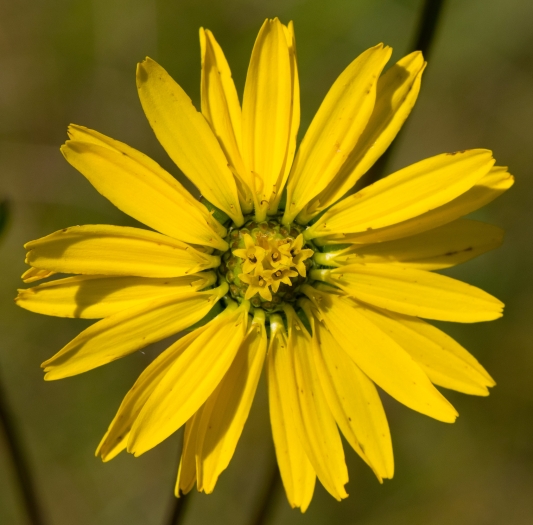Prairie Rosinweed
(Silphium terebinthinaceum)
Prairie Rosinweed (Silphium terebinthinaceum)
/
/

Joshua Mayer
CC BY-SA 2.0
Image By:
Joshua Mayer
Recorded By:
Copyright:
CC BY-SA 2.0
Copyright Notice:
Photo by: Joshua Mayer | License Type: CC BY-SA 2.0 | License URL: https://creativecommons.org/licenses/by/2.0/ | Uploader: wackybadger | Publisher: Flickr |





















































Estimated Native Range
Summary
Silphium terebinthinaceum, commonly known as Prairie Rosinweed, is a deciduous perennial herb native to tallgrass prairies and glades in the central and eastern United States, extending into Ontario. It can reach a height of 3 to 10 feet (1 to 3 meters) with a spread of 2 to 4 feet (0.6 to 1.2 meters). The plant features large, rough-textured, spade-shaped leaves that are vertically oriented in a north-south direction, an adaptation that minimizes water loss and overheating. During the summer, Prairie Rosinweed produces clusters of small, showy yellow flowers about 2–2+1⁄2 inches (5–6 cm) in diameter, which are attractive to pollinators. Its deep taproot, capable of reaching at least 14 feet (4 meters) deep, allows it to access water during droughts and contributes to its resilience.
Prairie Rosinweed is valued for its drought resistance and its ability to thrive in a range of soil conditions, from dry to moist, and in loamy to rocky soils. It is often used in prairie restoration projects, naturalized areas, and wildflower gardens for its ecological benefits and low maintenance requirements. In cultivation, it requires full sun and can tolerate various drainage conditions. While it is generally robust, it can show signs of stress, such as brown patches on leaves, due to extreme drought, wind damage, or leaf damage. However, it recovers well from disturbances like wildfires due to its extensive root system.CC BY-SA 4.0
Prairie Rosinweed is valued for its drought resistance and its ability to thrive in a range of soil conditions, from dry to moist, and in loamy to rocky soils. It is often used in prairie restoration projects, naturalized areas, and wildflower gardens for its ecological benefits and low maintenance requirements. In cultivation, it requires full sun and can tolerate various drainage conditions. While it is generally robust, it can show signs of stress, such as brown patches on leaves, due to extreme drought, wind damage, or leaf damage. However, it recovers well from disturbances like wildfires due to its extensive root system.CC BY-SA 4.0
Plant Description
- Plant Type: Herb
- Height: 3-10 feet
- Width: 1-3 feet
- Growth Rate: Moderate
- Flower Color: Yellow
- Flowering Season: Summer, Fall
- Leaf Retention: Deciduous
Growth Requirements
- Sun: Full Sun
- Water: Medium
- Drainage: Slow, Medium, Fast
Common Uses
Bee Garden, Bird Garden, Border Plant, Butterfly Garden, Drought Tolerant, Fragrant, Low Maintenance, Rabbit Resistant, Showy Flowers, Water Garden
Natural Habitat
Native to tallgrass prairies and glades in the central and eastern United States, including Ontario
Other Names
Common Names: Prairie Dock, Basal-Leaf Rosinweed, Dock-Rosinweed, Prairie Dock, Harzige Becherpflanze, Silphe Térébenthine, Spirsolört
Scientific Names: , Silphium terebinthinaceum, Silphium rumicifolium, Silphium terebinthinaceum var. lucy-brauniae, Silphium lanceolatum, Silphium terebinthinaceum var. sinuatum, Silphium chichamangense, Silphium chickamaugense,
GBIF Accepted Name: Silphium terebinthinaceum Jacq.